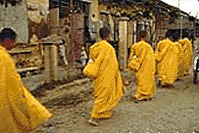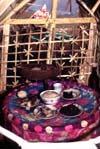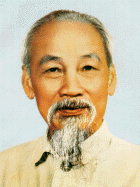






Vietnam has two mountains, Truong Son and Hoang Lien. Truong Son to the west run from north to south separating Vietnam from Laos and Cambodia. Hoang Lien runs from southern China to North Vietnam. Vietnam's highest peak, Fan Si Pan (3,143 m), is located in Hoang Lien. Over half of the highlands are cover with jungle, containing wild animals such as tigers and elephants. A quarter of the population lives in the highland.
There are over two hundred river flows down from the mountain. Two of Vietnam longest river is the Red River in the north and the Mekong River to the south. The rivers formed wild deltas make up of silt, sand and rock that are good for farming, because it have the nutrient that plants need.
People
More than 85 percent of Vietnam's people are ethnic Vietnamese. These are the Vietnamese that their ancestors settled in the north long ago. The ethnic Vietnamese have the strongest influence on the culture and the government. As century past by the since Vietnamese settle in the north, they expand their territory to the south. These cause other peoples into remote hill and mountain regions.
The remote hill of north and central Vietnam are home to over 30 different tribes. Some have lived in Vietnam for thousands of years. Each tribe has its own language, religious beliefs, and traditions.
There are more than 50 other people, such as Muong, Tai, Khmer, Cham, and Chinese, live throughout Vietnam. Most live in the hills but descendants of the Chinese lives in the cities. Most have struggled to keep their own languages and traditions.
 Culture
Culture
Vietnamese culture is influenced by many other places. Throughout Vietnam history, foreign peoples introduced their way of life and customs into Vietnam culture. The Chinese had a great influence on Vietnam; Vietnamese began to following Chinese religion, used Chinese writing symbols and medical practices. India influenced Vietnam through trade and once a powerful Cham and Khmer peoples also influenced Vietnamese. French rulers brought their European beliefs and customs. During the Vietnam War the Americans also introduced their way of life in to Vietnam.
Vietnamese Fashion
One of Vietnamese traditional clothes is ao dai, meaning long shirt is wore by women. It has long sleeves, a short collar, and slits up the sides. It is usually worn with baggy pants underneath.
Vietnam tend to be sunny and hot most of the time so people worn a cone-shaped hats to protect themselves from the sun. These hats are called non la.

Rice
Rice is Vietnam most important crop. Almost no meal goes by without it, as a matter of fact, Vietnamese often don't even call it a meal if it doesn't include rice. Whenever they have lunch or diner they call an cam, meaning eating rice. Vietnam had an old saying that if you have money you eat rice otherwise you eat congee. In many areas rice is still consider money - traditionally it was use as currency.
 Religion
Religion
Most of the religion in Vietnam came from other parts of the world. Chinese rulers brought Taoism and Confucianism to Vietnam. In 100 AD, monks from neighboring countries introduced Buddhism to Vietnam. Because of the influences from China and India, most people in Vietnam are Confucian, Taoist and Buddhist beliefs. Christian faith began when Europeans traveled to Vietnam in the 1600s. Roman Catholicism spread during French rule and now one in ten Vietnamese is Christian.
The Cao Dai faith created in Vietnam. More than two million people are Cao Dai. They believe in one God, a female called Mother Goddess. Cao Dai accept the teaching of Muhammad, Jesus, Buddha, and many other teachers.
Family
In a Vietnamese family, parents, children, grandparent, aunts, uncles and cousins, are big part of the family and often all live together in the same house. Respect is very important in a family; you must always respect the elders and those older than you. There is no you or I in the family; you must always refer to yourself in relation to the person you're speaking to. For example, when you speak to your mom instead of saying I you would said, "con" meaning son or daughter and you would call her "me" (mom) always.
Elderly
In Vietnam it is one of the principal duties of the children to take care of their aging parents and to tend the graves and altars of the ancestors. When the father died the eldest son in the family is require to carries the grave walking backward all the way from home, until he is buries. The oldest son has the responsibilities of taking care of the elder. It is believe that the daughter will be wed away and live with her husband and take care of his side of the family.
Celebration
Baby's first birthday
The baby birth is the only birthday that a person celebrates. After one month of birth the Vietnamese celebrate the baby birthday. Family and friends are invited to a party where the parents officially introduce the baby. Beside the baby family no one see the baby before it reaches one month. Vietnamese people believed that it is bad luck to see the baby during it first month of life. After this first party, a person's individual birthday is no longer celebrated.
Tet
The single most important festival of the year is Tet (Lunar calendar: Month 1, Day 1). Tet meaning New Year, it is held at the same date as Chinese New Year. It's like Christmas and Thanksgiving and everybody's birthday all rolled up in one, because in Vietnam people don't really celebrate Christmas, Thanksgiving or their Birthday. The country quite literally stops for a week while everyone hurries around preparing for the big event(s). Flights in and out of the country are booked up to a year in advance. Many from Canada and other countries go back to home to their family at this time.
On the fifteenth day of the eighth lunar month is considers to be the moon birthday or Tet Trung-thu is held. It is the Moon Festival, because the moon is largest and brightest at this time of year. Children make lanterns and eat moon cakes, made with rice, peanuts, raisins, watermelon seeds, and eggs. The Moon Festival is like Thanksgiving here in Canada.
Language
For many centuries, the Vietnamese language has shared its roots with the Chinese, Cambodian, and the Thai language. Vietnamese is the official language but other language is also spoken in Vietnam such as French, Chinese, and English. The Vietnamese language is monosyllabic meaning every word has 1 syllable only. It is also very tonal, meaning a word depends on the tone of one's voice; for example, the word "dong" could mean currency, east, or even dragon, but it is dependant on the way one would say the word. Another example would be "ma"; it may mean cheeks, ghosts, are mother. Depending on whom you talk to, there are fifteen ways to identify yourself to another, but in English, there is only "I". 
The Chinese has the most influences upon the Vietnamese literature. For a certain time period during Chinese over the Vietnamese, Chinese language has been used in scripts, poems, and many part of its writing. Vietnamese was only a spoken language at that time. When the Chinese were overruled, Vietnamese scholars developed Chu-Nom, which was the use of Chinese symbols to write Vietnamese words during the 1200's AD.
In the 1600's, a new way of the language called quoc ngu. This writing system is based on letters and their sounds. This language was the basic Latin alphabet but there were additional symbols representing tones as describe before. It was first not accepted by the Vietnamese people who resented the presents of the Europeans. By the 20th century, the quoc ngu system became very popular and is taught in public school along with French. It is also the common writing system used today.
Education
94% of Vietnamese people could read and write even though 3,000 schools were destroyed during the Vietnam War. Despite the result of the destruction of the schools, it has been rebuilt and improved dramatically. There are a total of 12 million students in Vietnam. Classrooms tend to be crowd because of the teacher shortage in Vietnam economy. A child starts school at the age of 6 and was required to finish 12 years of school.
Demography
A table comparing the Demography of Vietnam to that of Canada.
| VIETNAM | CANADA | |
|---|---|---|
| AREA | 331,653 sq. km | 10,000,000 sq. km |
| Population | 80,000,000 | 30,000,000 |
| Population Distribution | 76% rural and 24% urban | N/A |
| Capital | Hanoi (2,500,000pop.) | Ottawa (1,000,000pop) |
| Other Major City | Ho Chi Minh City(4,000,000pop.) Hai Phong (1,500,000pop.) | Toronto (4,000,000pop)Vancouver (1,200,000pop) |
| Language | Vietnamese | English |
| Literacy Rate | 94% | 98% |
| Life Expectancy | 64 | 75 Male 82 Female |
| Infant Mortality | 54 | 12 |
| Capital Income | $250 | $20000 |
| Currency | Dong | Dollar |
| Form of Government | Socialist Republic | Federal parliamentary state |
| Head of State | President | Queen |
| Ethnic Groups | 85% Vietnamese; reminder are Chinese, Tai, Khmer, Muong, Thai, Nung, Meo, Man, and Cham | French, British, German, Italian, Chinese, First Nation People, Ukranian, Dutch. |
| Major Religion | Buddhist | Christian |
